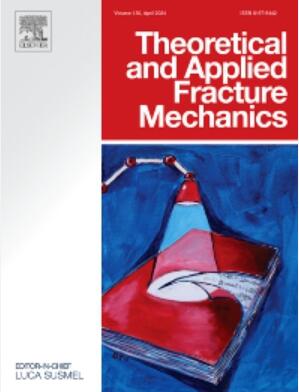评估采用 SBS 和 SEBS 改性剂的石硫合剂沥青的断裂性能
IF 5
2区 工程技术
Q1 ENGINEERING, MECHANICAL
引用次数: 0
摘要
本研究探讨了苯乙烯-丁二烯-苯乙烯(SBS)和苯乙烯-乙烯-丁烯-苯乙烯(SEBS)在不同加载速率下对石硫合剂沥青(SMA)断裂性能的影响。半圆形弯曲(SCB)试验是在 25 °C、缺口角为 0° 和 45°、加载速率为 0.5、1 和 5 mm/min 的条件下进行的。根据力-位移曲线得出了最大载荷、延展性和断裂能等关键参数。结果表明,SEBS 改性样品的断裂能始终高于 SBS 改性样品,尤其是在加载速率较低的情况下。具体来说,在 45° 缺口角处,加载速率为 0.5 和 1 mm/min 时,SEBS 的断裂能分别比 SBS 高出 43% 和 68%,这归因于 SEBS 具有更高的抗拉强度和模量,可在断裂前吸收更多能量。然而,在最高加载速率(5 毫米/分钟)下,SBS 的性能比 SEBS 高出 25%,这归因于其卓越的粘弹性能和硬度,在更高速度下可改善能量吸收和分布。与 SEBS 相比,SBS 试样的延展性较低,SEBS 由于塑性变形时间有限,裂纹扩展较早,而 SBS 由于具有较高的断裂伸长率和较高的粘度,在失效前可承受较大的变形,从而减缓了裂纹扩展。断裂能-CMOD 指数有效评估了聚合物添加剂对 SMA 断裂行为的影响,其值越高,表明 SMA 在负载下的性能越好。在 0° 缺口角度下,SEBS 的性能优于 SBS,这是因为其抗拉强度更高;而在 45° 缺口角度下,SBS 的性能更优,这不仅是因为其硬度更高,还因为其粘度更高、断裂伸长率更大、粘弹性更强,因此在拉力和剪切力的共同作用下能更好地抵抗裂纹扩展。本文章由计算机程序翻译,如有差异,请以英文原文为准。
Evaluating fracture performance of stone mastic asphalt with SBS and SEBS modifications
This study investigates the effects of styrene–butadiene–styrene (SBS) and styrene-ethylene-butylene-styrene (SEBS) on the fracture properties of stone mastic asphalt (SMA) at various loading rates. Semi-circular bending (SCB) tests were performed at 25 °C with notch angles of 0° and 45° at loading rates of 0.5, 1, and 5 mm/min. Key parameters such as maximum load, ductility, and fracture energy were derived from force-displacement curves. The results showed that SEBS-modified samples consistently exhibited higher fracture energy than SBS-modified samples, particularly at lower loading rates. Specifically, at a 45° notch angle, the fracture energy of SEBS was 43 % and 68 % higher than SBS at loading rates of 0.5 and 1 mm/min, respectively, attributed to the higher tensile strength and modulus of SEBS, allowing greater energy absorption before failure. However, at the highest loading rate (5 mm/min), SBS outperformed SEBS by 25 %, attributed to its superior viscoelastic properties and hardness, which improve energy absorption and distribution at higher speeds. While SBS specimens exhibited lower ductility compared to SEBS, SEBS propagated cracks earlier due to limited time for plastic deformation, whereas SBS, with its higher elongation at break and greater viscosity, slowed crack propagation by accommodating larger deformations before failure. The fracture energy-CMOD index effectively evaluated the impact of polymer additives on the fracture behavior of SMA, with higher values indicating improved performance under load. SEBS outperformed SBS at a 0° notch angle due to its higher tensile strength, While SBS excelled at a 45° notch angle, this advantage was not solely due to its greater hardness but also attributed to its higher viscosity, greater elongation at break, and viscoelastic behavior, which allowed it to better resist crack propagation under combined tensile and shear forces.
求助全文
通过发布文献求助,成功后即可免费获取论文全文。
去求助
来源期刊

Theoretical and Applied Fracture Mechanics
工程技术-工程:机械
CiteScore
8.40
自引率
18.90%
发文量
435
审稿时长
37 days
期刊介绍:
Theoretical and Applied Fracture Mechanics'' aims & scopes have been re-designed to cover both the theoretical, applied, and numerical aspects associated with those cracking related phenomena taking place, at a micro-, meso-, and macroscopic level, in materials/components/structures of any kind.
The journal aims to cover the cracking/mechanical behaviour of materials/components/structures in those situations involving both time-independent and time-dependent system of external forces/moments (such as, for instance, quasi-static, impulsive, impact, blasting, creep, contact, and fatigue loading). Since, under the above circumstances, the mechanical behaviour of cracked materials/components/structures is also affected by the environmental conditions, the journal would consider also those theoretical/experimental research works investigating the effect of external variables such as, for instance, the effect of corrosive environments as well as of high/low-temperature.
 求助内容:
求助内容: 应助结果提醒方式:
应助结果提醒方式:


